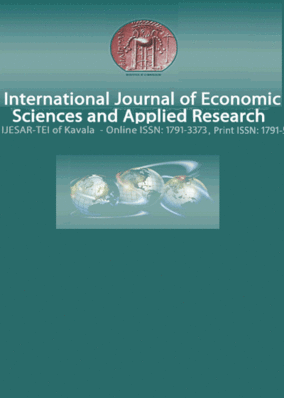The interrelationship between money supply, prices and government expenditures and economic growth : a causality analysis for the case of Cyprus
Part of : International journal of economic sciences and applied research ; Vol.5, No.3, 2012, pages 115-128
Issue:
Pages:
115-128
Abstract:
This paper investigates the short run as well the long run relationships between money supply, inflation, government expenditure and economic growth by employing the Error Correction Mechanism (ECM) and Johansen co-integration test respectively for the case of Cyprus using annual data from 1980 to 2009. Collectively, empirical results imply that public spending promotes economic development in Cyprus. However, deficit financing by the government causes more liquidity effects but also inflationary pressure in the economy. Results show that inflation negatively effects economic growth probably due to adverse supply shock. Money supply should be allowed to grow according to the real output of the economy but excess growth of money causes inflationary pressure in case of Cyprus. Therefore, this paper suggests that the government should control its current expenditure that stimulates aggregate demand and to focus more on development expenditure which stimulates aggregate supply and increases real output level.
Subject (LC):
Keywords:
economic development, co-integration, granger causality, deficit financing
Notes:
Περιέχει πίνακες και βιβλιογραφία
References (1):
- Albatei, H.A., 2000, ‘The Relationship between Government Expenditure and EconomicGrowth in Saudi Arabia’, Journal of King Saud University, 2, 12, pp. 173-191.Choi, G.W. and Devereux B.M., 2006, ‘Asymmetric Effects of Government Spending:Does the Level of Real Interest Rates Matter?’, IMF Staff Papers, 53, pp. 147-182.Demeri, D., Duck, W.N. and Musgrave, W.S., 2004, ‘Unanticipated money growth, outputand unemployment in West Germany, 1964-1981 ’, Review of World Economics, 120, 2,pp. 244-255.Dickey, D.A. and Fuller, W.A., 1979, ‘Distribution of the Estimators for AutoregressiveTime Series with a Unit Root’, Journal of the American Statistical Association, 74, pp.427-431.Engle, R.F. and Granger, C. W. J., 1987, ‘Co-integration and Error-Correction: Representation,Estimation and Testing ’, Econometrica, 55, pp. 251-256.Granger, C.W.J., 1969, ‘Investigating Causal Relations by Econometric Models and Cross-Spectral Methods’, Econometrica, 37, pp. 424-438.Han, S. and Mulligan B.C., 2008, ‘Inflation and the Size of Government’, Federal ReserveBank of St. Louis Review, 90, 3, pp. 245-267.Hassapis, C., Pittis, N. and Prodromidis, K., 1999. ‘Unit roots and Granger Causality inthe EMS Interest Rates: The Gentian Dominance Hypothesis Revisited’, Journal ofInternational Money and Finance, 18, pp. 47-73.Hsieh, E. and Lai, S.K., 1994, ‘Government Spending and Economic Growth: The G-7Experience’, Applied Economics, 26, 1, pp. 535-542.Jiranyakul, K. and Brahmasrene, T, 2007, ‘The Relationship between GovernmentExpenditures and Economic Growth in Thailand ’, Journal of Economics and EconomicEducation Research, 8, 1, pp. 93-102.Johansen, S. and Juselius, K., 1990, ‘Maximum Likelihood Estimation and Inferenceon Cointegration with Applications for the Demand for Money’, Oxford Bulletin ofEconomics and Statistics, 52, pp. 169-210.Johansen, S., 1988, ‘Statistical Analysis of Co-integration Vectors’, Journal of EconomicDynamics and Control, 2, pp. 231-254.Judd, K.L., 1989, Optimal Taxation: Theory and Evidence ’, Working paper, StanfordUniversity. Karpetis, C., 2006, ‘Inflation Targeting and the Multiplier Accelerator Principle’, Journalof Applied Business Research, 22, 4, pp. 103-118.Koeda, J. and Kramarenko V., 2008, ‘Impact of Government Expenditure on Growth: TheCase of Azerbaijan ’, IMF working paper.Lucas, R. and Stokey, N.L., 1983, Optimal Fiscal and Monetary Policy in an Economywithout Capital’, Journal of Monetary Econ omics, 12, l,pp. 55-93.MacKinnon, J.G., 1996, ‘Numerical Distribution Functions for Unit Root and Cointegration Tests’, Journal of Applied Econometrics, 11, pp. 601-618.Mehmood, R. and Sadiq S., 2010, ‘The Relationship between Government Expenditureand Poverty: A Cointegration Analysis ’, Romanian Journal of Fiscal Policy, 1, 1, pp.29-37.Nurudeen, A. and Usman, A., 2010, ‘Government Expenditure and Economic Growthin Nigeria, 1970-2008: A Disaggregated Analysis’, Business and Economics Journal,2010: BEJ-4, publically available at [http://astonjournals.com/bejarch.html].Schwartz, G., 1978, ‘Estimating the Dimension of a Model’, The Annals of Statistics, 6,pp. 461-464.




